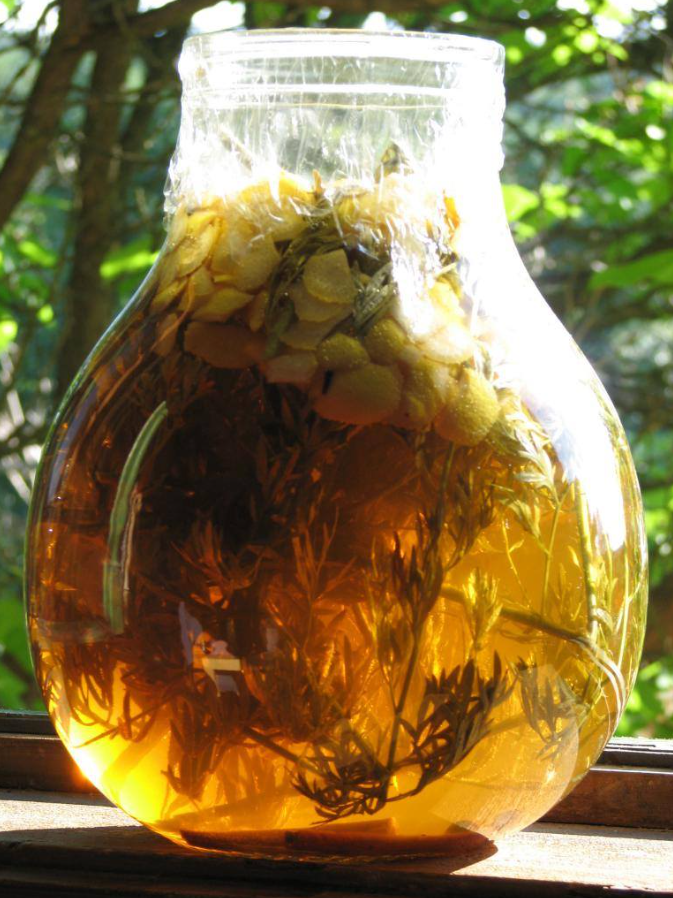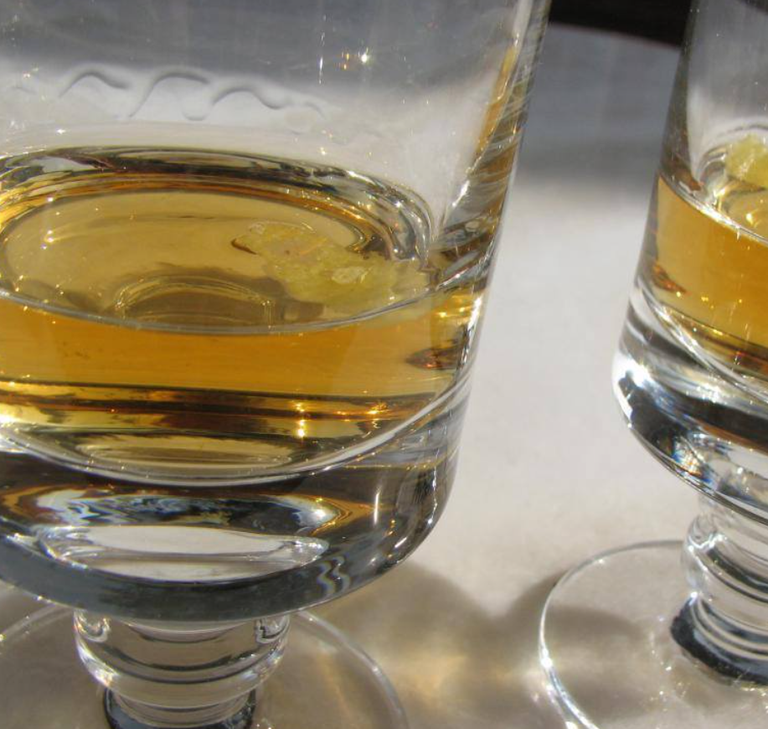How to Make Vermouth and Wormwood Wine: Crafting Traditional Winter Spirits
Hello, Hive Community! 🌟
We're warm and cold in these winter holidays and I'm thrilled to share a heartwarming tradition from my family.

Picture this: December arrives, and the air is filled with the aroma of our homemade winter spirits, featuring the exquisite flavors of vermouth and wormwood wine. These delightful concoctions, crafted with love using time-honored European recipes, play a special role in our festive celebrations. My parents started preparing the wine in September and the vermouth in August, sometimes even in May with silver wormwood, as they called it.
Now, I can't contain my excitement—I'm about to spill the secrets behind these cherished recipes and extend a warm invitation for you to experience their magic firsthand.
Ready to embark on a flavorful journey with me? Let's dive in! 🍷🎉
Vermouth:

Pic from last time mother made vermouth
Vermouth, an aromatic fortified wine, is concocted from white and red wines blended with refined alcohol, sugar syrup, and a macerate of various herbs. Key characteristics of vermouth include a higher alcohol content compared to regular wines (around 16°-18°C), a distinct yet moderate herbal aroma, and a balanced sweetness ranging from 80-150 g/l.
To achieve the signature vermouth flavor, a macerate is prepared from 14-16 dried herbs, flowers, fruits, and roots. These are ground, mixed, and macerated with wine distillate for several weeks before being pressed. The resulting liquid is filtered and stored in special glass or wooden containers, ready to be used in crafting vermouth.
The plants and flowers used in the maceration process include wormwood, yarrow, mugwort, hawthorn, caraway, coriander, anise, hyssop, valerian, dog rose, elderflower, chamomile, and rose.
Vermouth varieties are categorized based on alcohol content:
Simple and superior vermouths with 17°-18° alcohol.
Fine and special vermouths with 16° alcohol.
Extra-fine vermouths with 16° alcohol.
Dry vermouths with 10° alcohol.
Vermouths can be either pale yellow or red, depending on the grape varieties used. They are bottled in 500 ml, 750 ml, and 1000 ml special bottles, sealed with corks and paper or foil caps, labeled with information such as the vermouth type, producing company, alcohol concentration, bottling date, and other relevant details.
Vermouths, depending on their sweetness and aroma, are recommended as digestive drinks, part of meal structures, or as aperitifs before meals. They are best served chilled, either neat, with a few drops of lemon juice, or accompanied by a lemon slice, and can be combined with various fine alcoholic beverages in 100–150 ml stemmed glasses.
And it was tasty. Here is another pic we made:

Wormwood Wine: (a delicious wine that can make one forget about any worries)


Pictures from mother's collection.
Wormwood wine, made with wormwood flowers and additional ingredients, is characterized by a unique bitter taste and distinctive aroma. During fermentation, the wormwood aroma infuses into the must, creating a pleasant bouquet. To enhance this flavor, quince slices are added to the must.
Wormwood wine comes in three varieties: dry wormwood, sweet wormwood, and May wormwood. In terms of color, wormwood wine can be either white or red. It is renowned for its aroma but is not excessively sweet. Sweet wormwood wine, however, has a specific aroma and a mildly sweet taste. It is prepared from selected grapes, arranged in a barrel with wormwood flowers and quince slices. The barrel is then filled, and sweet must is poured in, fermenting slowly along with the whole grape berries. In spring, around April-May, the grapes are pressed, resulting in wormwood wine, which is then bottled and ready for consumption.
Remember I told you about the silver wormwood? May wormwood, a special wine recommended and in high demand during May, is a superior regional wine where my parents grew up. To create this, a wormwood macerate with wine distillate is prepared and mixed with wine. The macerate includes dried wormwood flowers, tarragon, coriander seeds, aromatic cloves, gentian roots, cinnamon, quince, apples, and more. These components are crushed, placed in a glass container, macerated with wine distillate for several days, filtered, and then dosed in specified quantities into white or red wine.
Organoleptic analysis of wormwood wine should reveal a pleasant color (preferably ruby red or amber), a bittersweet taste, and a distinct aroma. Wormwood wine is bottled in 1000 ml containers, while white wormwood wine is bottled in 750 ml bottles. Storage conditions are the same as for regular wines.
Wormwood wine is recommended and served either as an aperitif in quantities of 100-150 ml or combined with other specific beverages in cocktails or as part of culinary menus in small quantities. It is best enjoyed at room temperature, with soda or separate mineral water, in a stemmed wine glass.
At the digestive system level, Wormwood's action has a soothing role in relieving bloating, indigestion, and cramps. It is effective in treating hypochlorhydric gastritis, duodenal ulcers, hepatitis, constipation, alleviating vomiting, enteritis, indigestion, biliary dyskinesia, kidney stones, renal edema, intestinal parasites, hemorrhoids, and loss of appetite.
Wormwood is beneficial against colds and the flu, boosts immunity, and has cardiovascular advantages (activating blood circulation, reducing blood cholesterol levels, and preventing atherosclerosis).
Wormwood wine is taken as a medicinal remedy, not as a table wine. The recommended dosage and treatment duration should not be exceeded. Consume three tablespoons of Wormwood wine daily, half an hour before main meals, for a week.
Soooo:
These traditional winter spirits, vermouth, and wormwood wine, bring a touch of European heritage to our festive tables. Crafted with care and using time-honored recipes, they offer a unique and delightful experience for those willing to explore the world of homemade beverages.
Feel free to try these recipes, savor the rich flavors, and create your winter traditions!
Thanks for reading!
With respect and care,
Zpek
P.S.: Wormwood wine boasts exceptional detoxifying properties, as well as anti-inflammatory and antiseptic effects.
It serves as an excellent hypotensive remedy for individuals dealing with hypertension. However, it's essential to note that wormwood wine is consumed as a medicinal elixir, not as a regular table wine. The recommended dosage and treatment duration should not be exceeded.
For therapeutic purposes, take one tablespoon of wormwood wine before or after meals, for a period of three weeks to a maximum of one month. This elixir is recommended for various conditions, including:
Bloating and indigestion
Hyperacid gastritis
Dyspepsia (digestive discomfort)
Constipation
Biliary dyskinesia
Cholecystitis (urination problems)
Kidney stones
Renal edema
Intestinal spasms
Liver diseases
Depression
Muscle pain
Memory loss
Intestinal worms
Sweating gland issues
Crohn's disease
Renal conditions
Clearing vision
Invigorating the heart and lungs
Atherosclerosis prevention
Blood vessel regeneration
Lowering triglycerides and cholesterol
Gout
Rheumatism
Activating circulation
Type II diabetes.
Remember, it is crucial to consult with a healthcare professional before incorporating wormwood wine into any treatment regimen.
Yay! 🤗
Your content has been boosted with Ecency Points, by @zpek.
Use Ecency daily to boost your growth on platform!
Support Ecency
Vote for new Proposal
Delegate HP and earn more
Hi @zpek
Please, read our community rules. Thanks.
Thank you, I shall do that!
Hi @zpek
Welcome to the community.
This post is very complete. I had no idea about this data and procedure for making vermouth, it is very interesting.
I also see that making these drinks is a beautiful family tradition, I hope you can maintain it for many years.
The description you give of the flavor is great, I can almost taste the contents of the bottles.
I also wanted to invite you to read our community rules. There we ask our users to share a minimum of 3 photos making or reviewing their amazing drinks. It will be great to see you in another post presenting another drink.
Once again, welcome to the community.
Yes, Sirena. I also hope to keep the tradition and I am thinking of starting to make these drinks on my own from now, without my mother's help. Yes, I will resume to three photos from now. And I might share more about what mother and father used to make for us or friends. Thank you once again!
This makes me very happy, I will be very happy to see those traditional (and non-traditional) drinks in the community. Once again welcome, I love that you are here.
Thank you very very much!
You've been curated by @plantpoweronhive! Delegations welcome!
Thank you!
Join the foodie fun! We've given you a FOODIE boost. Come check it out at @foodiesunite for the latest community updates. Spread your gastronomic delights on and claim your tokens.
Thank you! Can I also insert #foodie when I post about drinks made at home?
You're welcome @zpek and yes, you can.
Thank you! I shall keep this in mind.
You've been curated by @amazingdrinks! Delegations welcome!
Very much appreciated!
This is very beautiful and attractive I have just learned how to prepare this yummy drink hope to try it some day, thanks for sharing.
Thank you, Katherine. How about I'll be one of your followers from now on, feel free to follow me too, we we can read each other's posts.
Thank you @zpek, I just followed you too, thank you for coming by, good night 🌉